Serving 2,303 students in grades 9-12, Bixby High School ranks in the top 10% of all schools in Oklahoma for overall test scores (math proficiency is top 20%, and reading proficiency is top 20%).
The percentage of students achieving proficiency in math is 38% (which is higher than the Oklahoma state average of 25%). The percentage of students achieving proficiency in reading/language arts is 58% (which is higher than the Oklahoma state average of 27%).
The student:teacher ratio of 20:1 is higher than the Oklahoma state level of 15:1.
Minority enrollment is 39% of the student body (majority Hispanic), which is lower than the Oklahoma state average of 56% (majority Hispanic).
Quick Stats (2025)
- Grades: 9-12
- Enrollment: 2,303 students
- Student:Teacher Ratio: 20:1
- Minority Enrollment: 39%
- Graduation Rate: 95% (Top 10% in OK)
- Overall Testing Rank: Top 10%
- Math Proficiency: 38% (Top 20%)
- Reading Proficiency: 58% (Top 5%)
- Science Proficiency: 35% (Top 50%)
- Source: National Center for Education Statistics (NCES), OK Dept. of Education
Top Rankings
Bixby High School ranks among the top 20% of public schools in Oklahoma for:
Category
Attribute
Overall Rank
Math Proficiency
Reading/Language Arts Proficiency
Graduation Rate
School Overview
Bixby High School's student population of 2,303 students has grown by 28% over five school years.
The teacher population of 115 teachers has grown by 25% over five school years.
Grades Offered
Grades 9-12
Total Students
2,303 students
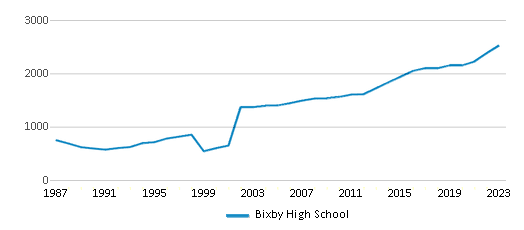
Gender %
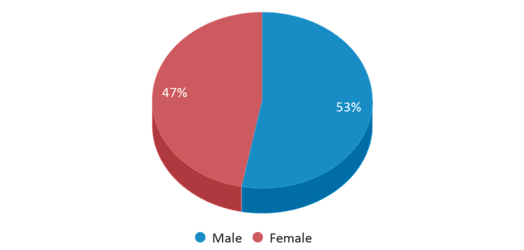
Total Classroom Teachers
115 teachers

Students by Grade
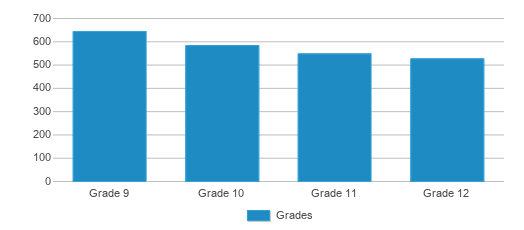
School Rankings
Bixby High School ranks within the top 10% of all 1,680 schools in Oklahoma (based off of combined math and reading proficiency testing data).
The diversity score of Bixby High School is 0.59, which is less than the diversity score at state average of 0.73. The school's diversity has stayed relatively flat over five school years.
Overall Testing Rank
#139 out of 1680 schools
(Top 10%)
(Top 10%)
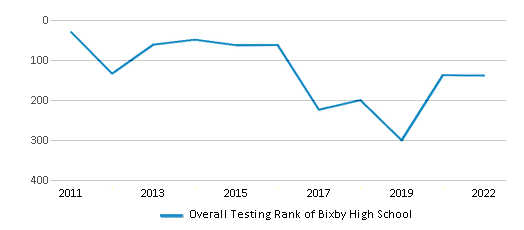
Math Test Scores (% Proficient)
38%
25%
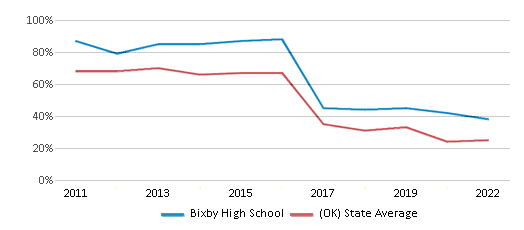
Reading/Language Arts Test Scores (% Proficient)
58%
27%
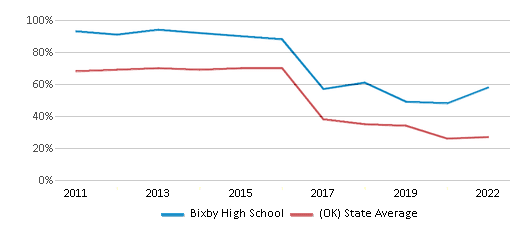
Science Test Scores (% Proficient)
35%
31%
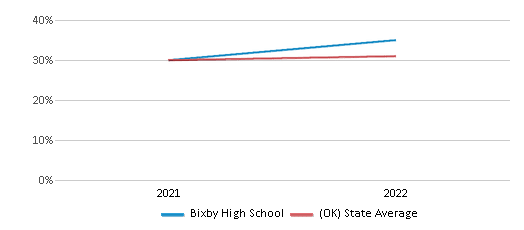
Student : Teacher Ratio
20:1
15:1
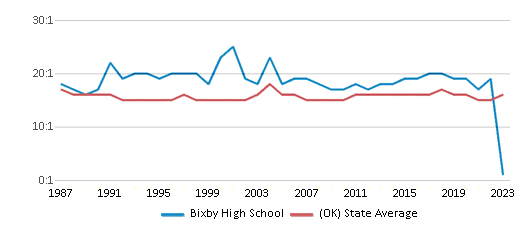
American Indian
4%
11%
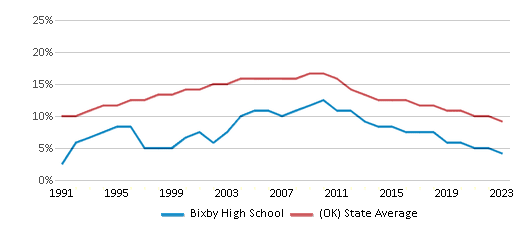
Asian
3%
2%
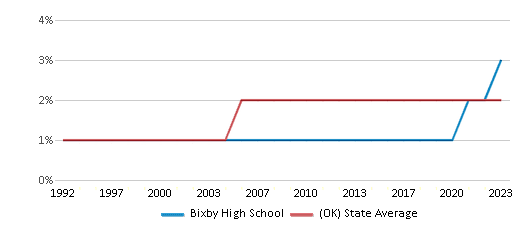
Hispanic
16%
20%
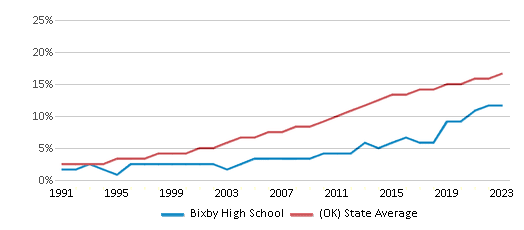
Black
2%
8%
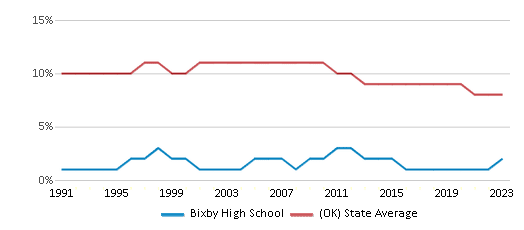
White
61%
44%
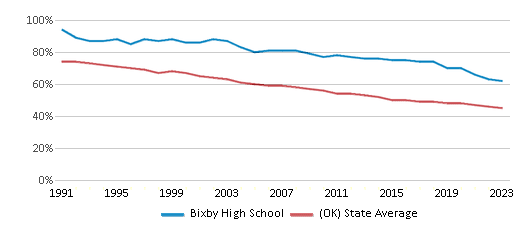
Hawaiian
n/a
1%
Two or more races
14%
14%
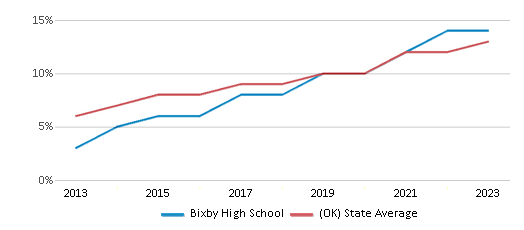
All Ethnic Groups

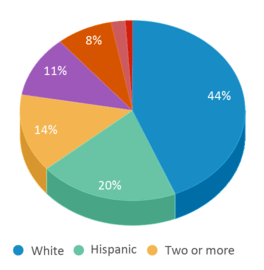

Graduation Rate
(20-21)95%
78%
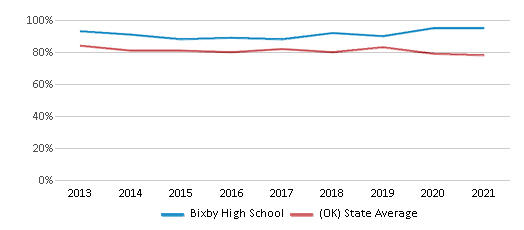
Participates in the National School Lunch Program (NSLP)
Yes
Eligible for Free Lunch
12%
48%

Eligible for Reduced Lunch
3%
7%
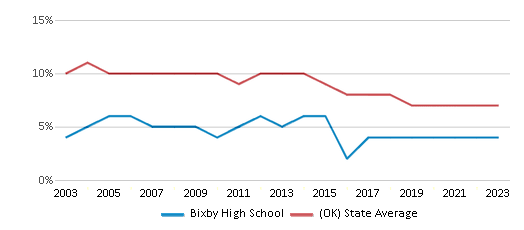
School Statewide Testing
School District Name
Source: National Center for Education Statistics (NCES), OK Dept. of Education
Profile last updated: 02/09/2025
Frequently Asked Questions
What is Bixby High School's ranking?
Bixby High School is ranked #139 out of 1,680 schools, which ranks it among the top 10% of public schools in Oklahoma.
What schools are Bixby High School often compared to?
Bixby High Schoolis often viewed alongside schools like Jenks High School, Broken Arrow High School by visitors of our site.
What percent of students have achieved state testing proficiency in math and reading?
38% of students have achieved math proficiency (compared to the 25% OK state average), while 58% of students have achieved reading proficiency (compared to the 27% OK state average).
What is the graduation rate of Bixby High School?
The graduation rate of Bixby High School is 95%, which is higher than the Oklahoma state average of 78%.
How many students attend Bixby High School?
2,303 students attend Bixby High School.
What is the racial composition of the student body?
61% of Bixby High School students are White, 16% of students are Hispanic, 14% of students are Two or more races, 4% of students are American Indian, 3% of students are Asian, and 2% of students are Black.
What is the student:teacher ratio of Bixby High School?
Bixby High School has a student ration of 20:1, which is higher than the Oklahoma state average of 15:1.
What grades does Bixby High School offer ?
Bixby High School offers enrollment in grades 9-12
What school district is Bixby High School part of?
Bixby High School is part of Bixby School District.
School Reviews
5 3/2/2019
Very quality schools. The best public education in the Tulsa area.
2 5/1/2012
AP classes are increasing. Band/Choir/Drama very good. Large variety of sports available. However, counseling very poor. Over all help with average students, very poor. Children are not prepared or even encouraged to go to college. Only the outstanding kids will get support. Average kids will definitely fall thru the cracks at this school. Administration and Counseling needs major overhaul!
5 3/9/2007
a. The quality of education is slightly above average. There are some really great teachers and staff and some equally terrible. The AP program is getting much better. I will say if you plan to go to college take the AP courses this school has to offer. I took AP History and English and would severly out of luck if I didn't.
B. A very good selection of extracurricular stuff! The music/drama program is great along with art and sports too.
C. I don't know much about this, I think we do really well in cheer and band.
D. very nice!
E. ?
Review Bixby High School. Reviews should be a few sentences in length. Please include any comments on:
- Quality of academic programs, teachers, and facilities
- Availability of music, art, sports and other extracurricular activities
Recent Articles

What Is A Charter School?
Explore the world of charter schools in this comprehensive guide. Learn about their history, how they operate, and the pros and cons of this educational innovation. Discover key facts about charter schools, including admission policies, demographics, and funding, as well as what to look for when considering a charter school for your child.

10 Reasons Why High School Sports Benefit Students
Discover the 10 compelling reasons why high school sports are beneficial for students. This comprehensive article explores how athletics enhance academic performance, foster personal growth, and develop crucial life skills. From improved fitness and time management to leadership development and community representation, learn why participating in high school sports can be a game-changer for students' overall success and well-being.

February 05, 2025
Understanding the U.S. Department of Education: Structure, Impact, and EvolutionWe explore how the Department of Education shapes American education, from its cabinet-level leadership to its impact on millions of students, written for general audiences seeking clarity on this vital institution.









